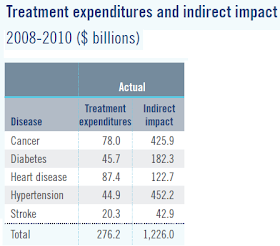Their report estimates costs for five most common chronic diseases: cancer, diabetes, heart disease, hypertension, and stroke. One set of costs are treatment costs; a much bigger cost is the reduction in GDP when people are unable to work to their usual productivity, or at all. Of course, the measure here underestimates the full social cost because it does not seek to place a monetary value on the costs of death and suffering.
Efforts to reduce the burden of chronic disease have had some successes. As the Milken report notes:
"Strategies to battle heart disease have had the most success in lowering prevalence and easing the economic burden. Much of the credit goes to public anti-smoking initiatives. ... Learning from that, we can be optimistic that aggressive campaigns to address obesity, improve nutrition, and motivate physical activity will bear fruit in the future. Simple physical movement not only helps to control weight but has been effective in cutting cholesterol levels. Keeping bad cholesterol in check through exercise and nutrition can restrain the menaces of stroke and hypertension. . . . More personalized treatment before disease onset can reduce incidence, and better disease management can curtail the need for sudden visits to expensive sites of services, such as emergency rooms and hospital admissions.The American College of Cardiology and American Heart Association now recommend statins for people at risk of heart disease. If diabetes patients and their doctors manage the disease well, they can avoid potentially grave glycemic events that send costs climbing. "
Similarly, the Centers for Disease Control notes on its website: "Four modifiable health risk behaviors—lack of physical activity, poor nutrition, tobacco use, and excessive alcohol consumption—are responsible for much of the illness, suffering, and early death related to chronic diseases."
In short, finding ways to deal better with the incidence of chronic disease offers the possibility of a three-way win: 1) better health and improved life expectancies for many 2) helping to hold down health care costs by avoiding costly episodes of hospitalization; and more speculatively, 3) the possible of building a new job-rich industry with the task of helping those with chronic diseases stick to their daily regimen.
This last point is worth a bit more explication. A chronic disease can be thought of as a set of conditions where the incidence and/or the severity of the condition can be greatly reduced if people f they take the recommended medications, or follow the recommended diet, or do the recommended exercises. However, if a person who already has with a chronic condition doesn't follow the day-to-day recommended regimen--say someone with high blood pressure or a diabetic--the result can be a severe and costly episodes of hospitalization. The U.S. health care system is generally quite good at dealing with poor health after it occurs, but traditionally, it has not been primarily focused on prevention, wellness, and helping peoples stick to their health regimens. The Milken report notes:
"Outside of the medical complex, there is much room for improvement in wellness and illness prevention initiatives. A range of organizations, such as employers, local government agencies, and nonprofits, can promote healthy living through wellness programs. Integrating exercise, nutrition awareness, and other good-for-you practices is the cornerstone of preventing chronic disease and reducing health-care costs."
Personal habits and public policies regarding cleanliness changed so much in the 19th and into the early 20th century that historians sometimes write of a "sanitation revolution," which led to dramatic improvements in public health. It's time to ramp up a "chronic disease revolution," which would include the health care system but also reach beyond it. Modern information technology, and the coming arrival of the "Internet-of-things" will open up new possibilities here. A pillbox could be wired into the Internet, and if it isn't opened at the appropriate times during the day, the person would receive a text or email, and then a phone call, and then maybe a personal visit of reminder. It's now possible for a home machine to take a small blood sample from a diabetic, analyze that sample, and send in the results. Information technology makes it much easier to have interactive systems that offer reminders about diet or exercise. The benefits from improved management of chronic conditions is potentially very large.
